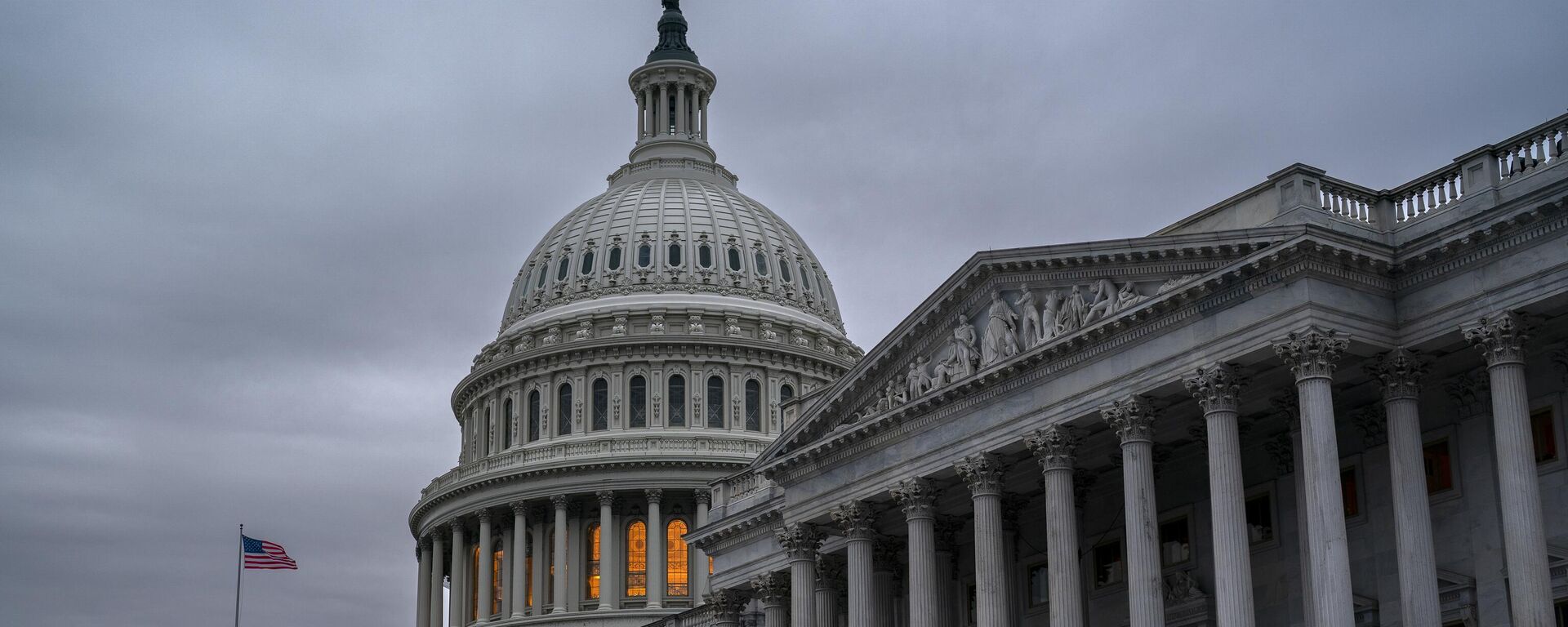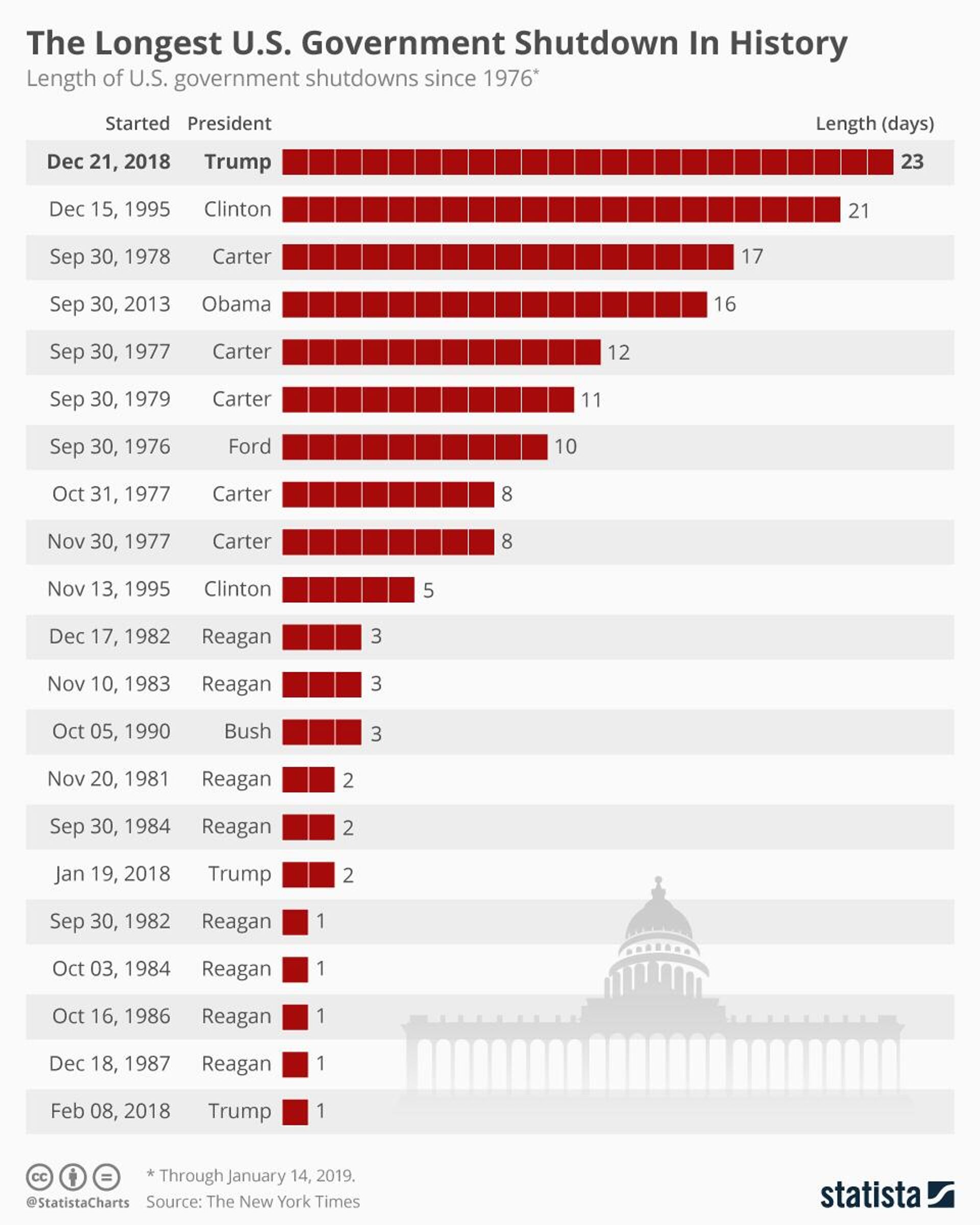https://sputnikglobe.com/20230928/impending-government-shutdown-how-will-americans-weather-the-storm-1113757491.html
Impending Government Shutdown: How Will Americans Weather the Storm?
Impending Government Shutdown: How Will Americans Weather the Storm?
Sputnik International
The looming threat of a US government shutdown raises concerns and casts uncertainty on the provision of public services and the job security of federal employees, as Americans brace for a potential impact on their daily lives.
2023-09-28T13:18+0000
2023-09-28T13:18+0000
2023-09-29T11:15+0000
world
americans
karine jean-pierre
samuel house
washington
congress
moody's
transportation security administration (tsa)
white house
medicare
https://cdn1.img.sputnikglobe.com/img/07e7/09/13/1113507937_0:0:3072:1728_1920x0_80_0_0_b1edc2955178f6deb27bfe9726bf692c.jpg
With the September 30 funding deadline fast approaching, the US government is on the brink of a shutdown unless Congress can swiftly reach a consensus on a dozen spending bills.This unlikely turn of events has ignited widespread concern among Americans, who are anxious to comprehend the potential fallout of such a scenario.A government shutdown occurs when Congress fails to approve fresh budget allocations for federal agencies. As of Monday, none of the 12 funding bills to sustain government programs had been passed. This stalemate is mainly down to divisions among House Representatives over general spending thresholds, while they seek various policy concessions from the Biden administration.Bad OmensLast month, Fitch's downgrade of the US in August 2023 underscored the message that the government's control over its spending had loosened both in the short and long term.Moody's reiterated that message on September 25 as the US rapidly approached a potential government shutdown on October 1. According to Moody's, federal interest payments are expected to rise to 4.6 percent of GDP by 2033, more than doubling the 1.9 percent recorded in 2022.During each of the 20 individual shutdowns since 1977, the government failed to fulfil its payment commitments for federal employees — although contractors still got paid.Who Is Affected?In the event of a government shutdown, non-essential federal workers would be temporarily laid off.The American Federation of Government Employees, a union representing federal federals, has highlighted that the most recent government shutdown from December 2018 to January 2019 forced around 420,000 public servants to keep working without pay. Another 350,000 staff were put on unpaid leave at the time.According to the US Office of Personnel Management, "excepted" employees who have to remain on duty during a shutdown are those with critical responsibilities, particularly the emergency services.Furloughed employees may be entitled to unemployment benefits, depending on the rules in their home state. Retired federal workers come off better, as they can expect their pension payments to continue without disruption.Army and Federal Law EnforcementThe Committee for a Responsible Federal Budget notes that active-duty military personnel and a major part of federal law enforcement officers would keep doing their jobs during a shutdown. Essential services like hospital care, traffic management and power grid maintenance will continue uninterrupted.However, benefits verification and card issuance activities would be temporarily suspended. In an overview of its shutdown plan last month, the Social Security Administration hinted that it would maintain "activities critical to our direct-service operations and those needed to ensure accurate and timely payment of benefits."Family WelfareAlmost 7 million mothers and children who rely on the Special Supplemental Nutrition Program for Women, Infants, and Children (WIC) can expect to receive their benefits throughout October.StudentsOn Monday, White House press secretary Karine Jean-Pierre announced that essential functions at Federal Student Aid are slated to continue for a couple of weeks in case of a shutdown. But according to Jean-Pierre, if the shutdown persists for more than a few weeks, it "could substantially disrupt the return to repayment effort and long-term servicing support for borrowers."VeteransSecretary of Veterans Affairs Denis McDonough stated last week that there will be no impact on veteran healthcare services and benefits, including compensation, pension, education and housing benefits, will continue to be processed and provided.Nevertheless, he pointed out that there will be limitations on some resources, including outreach initiatives, career counselling services, transition assistance and upkeep of cemetery grounds. Regional offices accessible to the public will be temporarily shuttered.Transport and RecreationCommercial flights are expected to maintain their regular schedules during a government shutdown. Air traffic controllers and TSA officers will operate without pay however, potentially resulting in airport staffing shortages. That would echo events during the partial government shutdown from late 2018 to early 2019, when a significant number of TSA agents were absent from work.During a shutdown, crucial services within national parks — such as restrooms, visitors' centers, campgrounds, information kiosks and interpretive programs — are halted. A significant portion of National Park Service staff are placed on furlough. Similarly, the Smithsonian museums in Washington, DC, would close their doors during a government shutdown.How a Government Shutdown Relates to National DebtDuring a US government shutdown, a complex interplay between revenue, spending, and borrowing dynamics comes into play, which can impact the nation's debt profile.As non-essential federal operations grind to a halt, government revenue is curtailed due to the closures of revenue-generating entities like national parks and museums. However, essential expenditures such as interest on the national debt and entitlement programs persist, leading to a continued accrual of expenses.To bridge the revenue-spending gap, the government may resort to increased borrowing, issuing additional Treasury securities. Prolonged or repeated shutdowns can erode market confidence, potentially resulting in higher interest rates on government debt as investors seek greater returns to offset perceived risks.
https://sputnikglobe.com/20230925/looming-government-shutdown-setting-us-up-for-credit-downgrade-food-benefits-loss-1113667185.html
https://sputnikglobe.com/20210926/us-treasury-could-run-out-of-cash-by-mid-october-think-tank-warns-as-government-shutdown-looms-1089414526.html
https://sputnikglobe.com/20230926/us-senate-advances-short-term-spending-bill-to-avert-looming-government-shutdown-1113706462.html
washington
Sputnik International
feedback@sputniknews.com
+74956456601
MIA „Rossiya Segodnya“
2023
Chimauchem Nwosu
https://cdn1.img.sputnikglobe.com/img/07e7/09/01/1113046371_0:99:1536:1635_100x100_80_0_0_9c5c627283eca931c39fe4852bbb301c.jpg
Chimauchem Nwosu
https://cdn1.img.sputnikglobe.com/img/07e7/09/01/1113046371_0:99:1536:1635_100x100_80_0_0_9c5c627283eca931c39fe4852bbb301c.jpg
News
en_EN
Sputnik International
feedback@sputniknews.com
+74956456601
MIA „Rossiya Segodnya“
Sputnik International
feedback@sputniknews.com
+74956456601
MIA „Rossiya Segodnya“
Chimauchem Nwosu
https://cdn1.img.sputnikglobe.com/img/07e7/09/01/1113046371_0:99:1536:1635_100x100_80_0_0_9c5c627283eca931c39fe4852bbb301c.jpg
us government shutdown, us government, funding deadline, congress, spending bills, us federal agencies, government operations, house republicans, us spending thresholds, policy concessions, fitch downgrade, moody's warning, us federal interest payments, us gdp, standard & poor's, us sovereign credit rating, american policymaking, us political institutions, us government shutdown effects, us federal workers, uncompensated leave, us office of personnel management, us armed forces, us federal law enforcement officers, social security, medicare checks, supplemental nutrition assistance program, snap, special supplemental nutrition program for women, infants, and children, wic, federal student aid, shutdown impact, veteran healthcare services, veterans affairs, us education benefits, us housing benefits, us commercial flights, us air traffic controllers, tsa officers, national parks, national park service, smithsonian museums, government shutdown and national debt, us government revenue, revenue-generating entities, u sinterest on the national debt, entitlement programs, us treasury securities, market confidence, interest rates, us long-term fiscal policies, tom vilsack, white house, denis mcdonough.
us government shutdown, us government, funding deadline, congress, spending bills, us federal agencies, government operations, house republicans, us spending thresholds, policy concessions, fitch downgrade, moody's warning, us federal interest payments, us gdp, standard & poor's, us sovereign credit rating, american policymaking, us political institutions, us government shutdown effects, us federal workers, uncompensated leave, us office of personnel management, us armed forces, us federal law enforcement officers, social security, medicare checks, supplemental nutrition assistance program, snap, special supplemental nutrition program for women, infants, and children, wic, federal student aid, shutdown impact, veteran healthcare services, veterans affairs, us education benefits, us housing benefits, us commercial flights, us air traffic controllers, tsa officers, national parks, national park service, smithsonian museums, government shutdown and national debt, us government revenue, revenue-generating entities, u sinterest on the national debt, entitlement programs, us treasury securities, market confidence, interest rates, us long-term fiscal policies, tom vilsack, white house, denis mcdonough.
With the September 30 funding deadline fast approaching, the US government is on the brink of a shutdown unless Congress can swiftly reach a consensus on a dozen spending bills.
This unlikely turn of events has ignited widespread concern among Americans, who are anxious to comprehend the potential fallout of such a scenario.
A government shutdown occurs when Congress fails to approve fresh budget allocations for federal agencies. As of Monday, none of the 12 funding bills to sustain government programs had been passed. This stalemate is mainly down to divisions among House Representatives over general spending thresholds, while they seek various policy concessions from the Biden administration.
Last month,
Fitch's downgrade of the US in August 2023 underscored the message that the government's control over its spending had loosened both in the short and long term.
Moody's reiterated that message on September 25 as the US rapidly approached a potential government shutdown on October 1. According to Moody's, federal interest payments are expected to rise to 4.6 percent of GDP by 2033, more than doubling the 1.9 percent recorded in 2022.

25 September 2023, 23:13 GMT
During each of the 20 individual shutdowns since 1977, the government failed to fulfil its payment commitments for federal employees — although contractors still got paid.
In the event of a government shutdown, non-essential federal workers would be temporarily laid off.
The American Federation of Government Employees, a union representing federal federals, has highlighted that the most recent government shutdown from December 2018 to January 2019 forced around 420,000 public servants to keep working without pay. Another 350,000 staff were put on unpaid leave at the time.
According to the US Office of Personnel Management, "excepted" employees who have to remain on duty during a shutdown are those with critical responsibilities, particularly the emergency services.
Furloughed employees may be entitled to unemployment benefits, depending on the rules in their home state. Retired federal workers come off better, as they can expect their pension payments to continue without disruption.
Army and Federal Law Enforcement
The Committee for a Responsible Federal Budget notes that active-duty military personnel and a major part of federal law enforcement officers would keep doing their jobs during a shutdown. Essential services like hospital care, traffic management and power grid maintenance will continue uninterrupted.
However, benefits verification and card issuance activities would be temporarily suspended. In an overview of its shutdown plan last month, the Social Security Administration
hinted that it would maintain "activities critical to our direct-service operations and those needed to ensure accurate and timely payment of benefits."

26 September 2021, 07:45 GMT
Almost 7 million mothers and children who rely on the Special Supplemental Nutrition Program for Women, Infants, and Children (WIC) can expect to receive their benefits throughout October.
"If the shutdown were to extend longer than that, there would be some serious consequences to SNAP," US Agriculture Secretary Tom Vilsack noted during a White House briefing on Monday.
On Monday, White House press secretary Karine Jean-Pierre announced that essential functions at Federal Student Aid are slated to continue for a couple of weeks in case of a shutdown. But according to Jean-Pierre, if the shutdown persists for more than a few weeks, it "could substantially disrupt the return to repayment effort and long-term servicing support for borrowers."
Secretary of Veterans Affairs Denis McDonough
stated last week that there will be no impact on veteran healthcare services and benefits, including compensation, pension, education and housing benefits, will continue to be processed and provided.
Nevertheless, he pointed out that there will be limitations on some resources, including outreach initiatives, career counselling services, transition assistance and upkeep of cemetery grounds. Regional offices accessible to the public will be temporarily shuttered.
Commercial flights are expected to maintain their regular schedules during a government shutdown. Air traffic controllers and TSA officers will operate without pay however, potentially resulting in airport staffing shortages. That would echo events during the partial government shutdown from late 2018 to early 2019, when a significant number of TSA agents were absent from work.
During a shutdown, crucial services within national parks — such as restrooms, visitors' centers, campgrounds, information kiosks and interpretive programs — are halted. A significant portion of National Park Service staff are placed on furlough. Similarly, the Smithsonian museums in Washington, DC, would close their doors during a government shutdown.
How a Government Shutdown Relates to National Debt
During a US government shutdown, a complex interplay between revenue, spending, and borrowing dynamics comes into play, which can impact the nation's debt profile.
As non-essential federal operations grind to a halt, government revenue is curtailed due to the closures of revenue-generating entities like national parks and museums. However, essential expenditures such as interest on the national debt and entitlement programs persist, leading to a continued accrual of expenses.

26 September 2023, 23:57 GMT
To bridge the revenue-spending gap, the government may resort to increased borrowing, issuing additional Treasury securities. Prolonged or repeated shutdowns can erode market confidence, potentially resulting in higher interest rates on government debt as investors seek greater returns to offset perceived risks.







